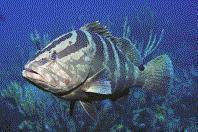
Reef Environmental Education Foundation (REEF) will be leading its second Grouper Moon Project in January 2003, in Little Cayman. In 2002, REEF volunteers and staff from the Cayman Islands Department of the Environment (CIDOE) documented a Nassau Grouper aggregation off the western tip of Little Cayman. The Project also monitored Nassau Grouper abundance, movement, and color phases at reefs around the island.
What is the Grouper Moon Project?
Groupers lead interesting lives, especially when it comes to reproduction. Normally solitary and territorial, during the winter full moons they travel, sometimes over great distances, and "group" together to spawn. Therefore the project name "Grouper Moon". About fifty of these spawning aggregations sites have been recorded in different places throughout the Caribbean. Historically, once discovered, grouper aggregation sites have become synonymous with fisherman aggregation sites. Due to the timing and site fidelity of the spawning aggregations and the ease with which these relative loners can be caught while congregating by the hundreds and thousands to spawn, one-third to one-half of the known Caribbean grouper aggregation sites are now inactive. The Cayman Islands used to be home to five spawning sites. Today, four of these sites are dormant or depleted. The same declining trend is true in spawning aggregation sites for many other areas of the world including the US.
In the winter of 2002, REEF coordinated a groundbreaking expedition to the Cayman Islands - the Grouper Moon Project. The Project's objectives were to observe the Nassau grouper (Epinephelus striatus) spawning aggregation off the western tip of Little Cayman, and to develop a protocol for monitoring their numbers and activity at the site. For two weeks, a team of divers that included five REEF volunteers, staff from the Cayman Islands Department of Environment, and led by REEF's Field Operations Coordinator, Leslie Whaylen, visited the aggregation site and nearby reefs. REEF will continue documenting this important event when returning to Little Cayman in January 2003 with a small team of scientists, videographers, CIDOE staff, and REEF expert fishwatchers. The team will be visiting the aggregation site, but additional help is needed from other volunteers to collect data from the surrounding reefs of the island.
How Can You Help?
If you would like to volunteer for this project by conducting fish surveys on Little Cayman's reefs such as along the famous Bloody Bay Wall, please contact Southern Cross Club's reservation office at 800-899-2582 or info@southerncrossclub.com for availability. The dates most needed are January 13-24. Sample package prices range from 7-night package ($1995) to 10-night package ($2820) and include daily 2 tank diving, accommodations, and meals.
Please mention the Grouper Moon Project when booking. Some of the proceeds from each package booked will be directed to the Grouper Moon Project. Please see http://www.reef.org/data/groupermoon.html or http://www.reef.org/webres/reefnotes.htm and click on Spring 2002 issue for more information on the Grouper Moon Project. For more information on REEF and the Fish Survey Project visit REEF's web site at www.reef.org.
